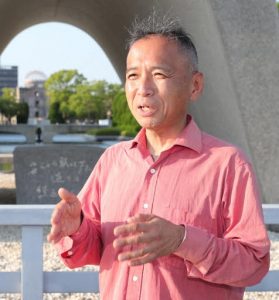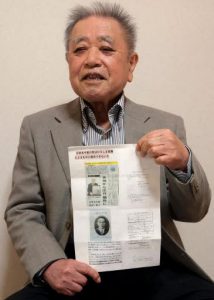Striving to fill voids in Hiroshima 75 years after the atomic bombing—Duty passed on to next generations, Part 1: In the hands of citizens
Jun. 16, 2020
Names finally added to register of A-bomb victims 75 years later—System for registering A-bomb victim names should be known more widely
by Kyosuke Mizukawa and Minami Yamashita, Staff Writers
On June 5, work began at Hiroshima City Hall to add names of A-bomb survivors who died to the city’s register of the A-bomb victims. Most of the names being added to the register this year are those of A-bomb victims who have died since August 6 last year. Some, however, were finally identified to have died in the atomic bombing after being lost in a forgotten “void” for many years.
At the age of two, Takehiro Yamaguchi was killed in the atomic bombing 75 years ago. In December last year, Takanori Masuda, 54, Takehiro’s nephew who now lives in the city’s Asaminami Ward, applied to the Hiroshima City government to add his uncle’s name to the register of the A-bomb victims. Mr. Masuda said, “I feel so sorry for him because it took so long.” Takehiro was a younger brother of Mr. Masuda’s late mother, Shizue. Her birth home was located 770 meters from the hypocenter. Five members of her family—Takehiro, her parents, and grandparents—all died in the bombing.
Starting in his childhood, Mr. Masuda and his mother would often visit Hiroshima Peace Memorial Park, located in the city’s Naka Ward, and place their hands together in prayer before the Cenotaph for the A-bomb Victims. His mother confessed a regret of hers once to her son. “Takehiro wanted me to share my popsicle with him, but I ended up eating it all myself,” she said. A hobby of Mr. Masuda’s is collecting old photographs of Hiroshima taken before the atomic bombing. When looking at the black-and-white photos, he ponders the daily lives of his mother and her family taken by the atomic bombing.
Takehiro was not listed as A-bomb victim
Mr. Masuda used to believe that the names of all five members of his mother’s family had been included in the register of the A-bomb victims, which is housed at the cenotaph in the park. However, after reading a series of Chugoku Shimbun feature articles last year on unclaimed victims, he became concerned whether that was truly the case. The register is not available to the public, but surviving family members of the victims can make inquiries to the city about names. Through that process, he discovered that Takehiro’s name had not been included in the register.
After hearing from Mr. Masuda about his finding, we interviewed city officials. We found that Takehiro’s death had not been picked up in the Atomic Bomb Victims Project, a survey conducted to identify the names of each individual killed in the atomic bombing. This means that he had not been counted among the 89,025 people the city confirmed as of the end of March last year to be the number of A-bomb victims who had died by the end of 1945.
What are the possible reasons for his name being missed? The government had difficulties in compiling the deaths of pre-school children at the time of the bombing because they were not likely to be listed in official documents such as school student directories. Completed applications for Atomic Bomb Survivor’s Certificates, which are stored by the Hiroshima City and Prefecture governments, also serve as information sources for the Atomic Bomb Victims Project. Shizue had submitted a certificate application form to Yamaguchi Prefecture, where she lived at the time of submission. In 1985, the Japanese national government conducted a survey of only A-bomb survivors who were still alive and had a certificate to identify family members of those who had died in the atomic bombing. Shizue, however, had died in 1982.
As he was applying for Takehiro’s name to be included in the city’s register of the A-bomb victims, Mr. Masuda tried to convey to his mother his feelings. “You and your younger brother can finally be united under the cenotaph,” he said. At the same time, he also had doubts. The names of Shizue’s deceased family members, including Takehiro, have been registered at the Hiroshima National Peace Memorial Hall for the Atomic Bomb Victims, and the visitors to the hall can search for them without restriction. Nonetheless, that information had not been reflected in the city’s register of the A-bomb victims kept in the same Peace Memorial Park. He wondered if it would be possible to also utilize the national government’s information on A-bomb victims in the city’s register.
In December last year, Akira Kodama, 85, a resident of the city of Higashihiroshima, inspired by the Chugoku Shimbun feature-article series, submitted an application form to the city offices with the aim of having the name of his father, Senri Kodama, listed in the register. “I thought it would be important to fill the void of even one victim’s name,” said Mr. Kodama. “I now believe my father’s soul will also find peace.”
Senri Kodama was a physician in the former village of Toyosaka (now part of Higashihiroshima). In the aftermath of the atomic bombing, he went to Hiroshima day after day with the intent to rescue residents of his village who had been mobilized in downtown Hiroshima to help dismantle buildings for the creation of fire lanes. He brought the wounded back to his hospital in the village on a truck. The following year, he suffered from a high fever and was confined to bed. In 1947, he died at the age of 47. Mr. Kodama said, “I have to believe my father died due to the effects of radiation.”
Citizens’ actions are key
Others tend to be missed in materials in the hands of the city government—not only victims who died by the end of 1945 but also those who experienced the atomic bombing and passed away before 1957, the year when issuance of the A-bomb Survivor’s Certificates began. That is why actions taken by citizens such as Mr. Kodama are an important key to filling in the voids in information that exist.
Our staff writer group in charge of the feature-article series received repeated inquiries from readers. “I want to confirm who is listed in the city’s register,” or “I’m worried that my mother’s name may not be included in the register” were common refrains. Victims’ family members have also aged. An urgent task for the city is to promote collaboration with the national government and other local governments to raise awareness of the system in place for application to add A-bomb victims’ names to the register and gain understanding of the Atomic Bomb Victims Project.
As of August 5 last year, a total of 319,196 people’s names had been included in the city’s register of the A-bomb victims. The names of Takehiro Yamaguchi and Senri Akira will be added to the latest volume of the register, which will be placed in the Cenotaph of the A-bomb Victims at the August 6 Peace Memorial Ceremony this year.
---
Although 75 years have passed since the atomic bombings, the entire picture of damage wrought by the atomic bombings has yet to be clarified. Through the interviews conducted for reporting on this article, the challenges in filling the “voids” in Hiroshima have now become clear. In this feature-article series, we will pursue the path that governments and citizens should pursue toward this goal.
(Originally published on June 16, 2020)









